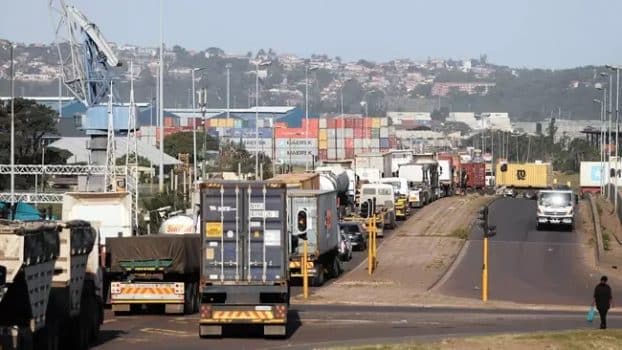
Durban – Depots around the Durban Port are congested with a backlog of non-essential goods cargo and empty containers that have not been transported due to the Covid-19 lockdown regulations.
The logistics congestion has also been exacerbated by historical problems of poor equipment maintenance.
SA Association of Ship Operators and Agents (SAASOA) chairperson Malte Kersten urged the government to move the lockdown to alert level 3 or 2 to enable the movement of non-essential cargo from the port and across provincial borders.
Kersten said that about 30 ships, including container vessels and oil tankers, were queuing outside the port on Wednesday.
He said the regulations were “too complicated” and had resulted in goods being stored in depots because transporters were not allowed to move them to factories and across provincial boundaries. “We need to go to level 3 or even better level 2 to open up the factories so that people can use materials again and shops can sell goods.
“We need to open up the economy because everyone is aware now of the need for social distancing and wearing of masks. They have bought time to prepare,” Kersten said.
However, Kersten said Covid-19 was also a convenient “cover-up” for the port’s historical inefficiencies which have seen queues of trucks blocking the entrances to both Pier 1 and 2 in recent weeks. He said the lack of maintenance of equipment meant that teams would start the day with 82 straddles, and by the afternoon would be operating with only 60 due to breakdowns.
A mobile harbour gantry caught alight in the port early yesterday, apparently due to a system malfunction.
Another port user, who asked to remain anonymous, said: “The port is working but there are challenges in terms of the booking system they have introduced, which has been causing a mess where people who haven’t booked are coming in Island View trucks are causing havoc,” he said.
He added that congestion caused by bulk carriers from Island View had blocked the entrance to Pier 1 and 2, and trucks carrying containers were therefore not able to drop off their loads at the scheduled time slots.
“If they didn’t have this booking system, massive trucks wouldn’t be lining up like this. The booking system is a disguise to manage the trucking problem. Everyone is complaining, but Transnet Port Terminals is not listening. Equipment is a problem,” he said.
Transnet said in a statement on Wednesday that industry stakeholders had “expressed satisfaction” with the progress made by a special task team set up to tackle traffic pressure and congestion in the port’s Bayhead Precinct and surrounding roads.
Participants included Transnet, the Department of Public Enterprises, the KwaZulu-Natal provincial government, eThekwini municipality, Durban metro police, SAPS, the Durban Chamber of Commerce and Industry, and the South African Association of Freight Forwarders (SAAFF).
Durban Port general manager Moshe Motlohi said: “In December, Transnet recognised the need to change its model of engagement with its stakeholders with regard to decongesting the Port of Durban.
“The decongestion task team meets fortnightly, and through nine targeted work-streams we have adopted an integrated approach to tackle the root causes of the Bayhead traffic-related congestion in the precinct and to ensure improved co-ordination, planning, operations, cargo flows and capacity.” He said stakeholders had agreed to several initiatives to improve the flow of containers into and out of the port to minimise delays.
“It has been encouraging to see improvements in key measures of efficiency including ships’ waiting time and turnaround time; reduced truck turnaround time and staging times; improved fluidity on Bayhead Road leading into the container terminals; and improved rail turnaround time.
“But we know we must not rest on our laurels and we will continue collaborating with all role-players to sustain these improvements,” he said.
SAASOA chief executive Peter Besnard said he was “pleased that finally we are beginning to see light at the end of this tunnel”.
Chairperson of the harbour carriers division of SAAFF, Sue Moodley, said Transnet had noted the industry’s feedback. “This has created much improvement to the truck booking system, and the quality of reports to the trucking industry. There is still much more work to be done by the larger logistics community.” – The Mercury






